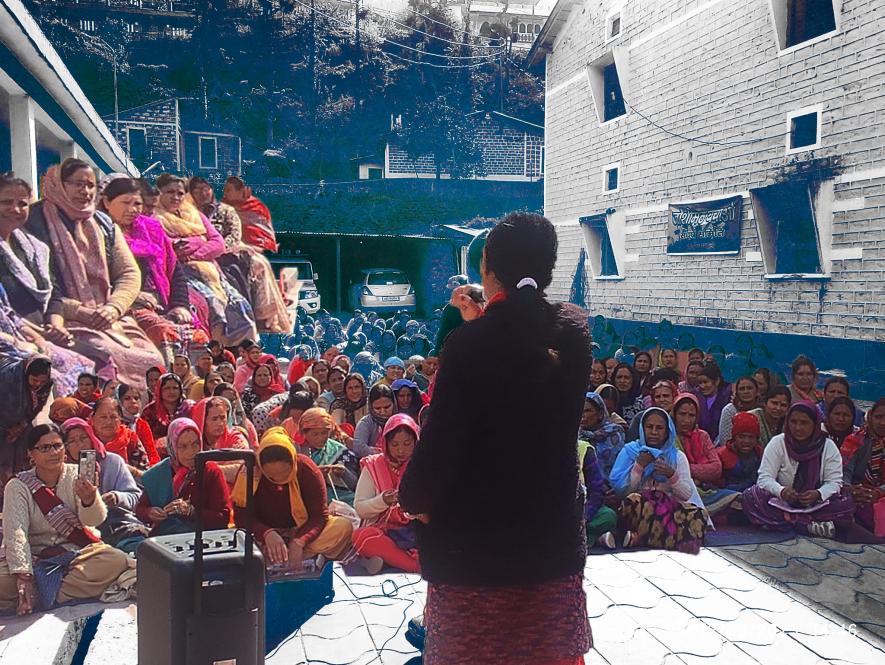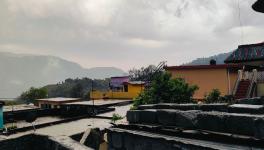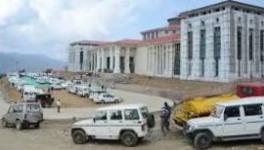Joshimath Sinking Due to Crony Capitalism, Not Natural Disaster or Act of God

Joshimath sinking is a disaster waiting to happen. Although cracks started appearing in buildings in late 2021, they have widened alarmingly, and new cracks have appeared in more than 800 houses and roads. According to images released by the National Remote Sensing Centre of the Indian Space Research Organisation, Joshimath has witnessed a rapid subsidence of nearly 5.4 cm in 12 days—between 27 December 2022 and 7 January 2023. ISRO also found a subsidence of almost 9 cm between April and November 2022. It has removed these details from its website after a government directive barred it from making public statements.
Joshimath town in the Chamoli district of Uttarakhand has a population of 20,000 and is on the pilgrimage route of the Badrinath and Hemkunt Sahib shrines. It also is a starting point for the international skiing site of Auli and the famous Valley of Flowers. The town is also strategically important due to its proximity to the Indo-China border.
There are reports that the immediate cause for the current subsidence may have been an aquifer below the town getting punctured during the construction of a tunnel by the National Thermal Power Corporation (NTPC) nearby. But Joshimath’s sinking has been years, if not decades, in the making. It is not a natural disaster but a manufactured environmental one. Its sinking has been triggered by numerous hydropower projects, large-scale hotel construction, and road-building projects, which ignored the load-bearing capacity of the region and the views of geologists and environmental experts.
Scientists and experts have been raising the alarm for decades. The MC Mishra Committee suggested a ban on heavy construction in Joshimath as far back as 1976, pointing out that it is located on a fragile site in an ancient landslide zone. The committee also recommended remedial measures, including afforestation and a proper drainage system. However, its suggestions went against the vested interests of politician-contractors, so the report was buried.
Though Joshimath is 1,000 years old, it is established on deposits of sand and stone—an old landslide zone—not a stable ground for large-scale human settlement. Its base is fragile and sensitive to any heavy construction. Still, Himalayan society has lived and flourished there in a most eco-friendly manner. Unfortunately, the rapacious nature of capitalism and the development policies and strategies of the current government towards the ecologically fragile and sensitive Himalayan region have steered it into this path of destruction. Neither natural disaster nor act of god, crony capitalism led to this disaster.
Vulnerable mountains
Joshimath is highly vulnerable to tectonic activities as it lies on a fault line. A nearby geological fault line almost touches Joshimath. In addition, the Main Central Thrust (MCT) also passes relatively close to the city. It is a geological fault where the Indian and the Eurasian plates collide, creating the lofty mountain ranges of the Himalayas. Compared to other mountain ranges, the Himalayas are relatively young and subject to more geological activity.
Joshimath has recently seen an explosion in the construction of hydropower projects, tunnels, and roads in the last few decades, ignoring all scientific opinions. Surface-level anthropogenic activities have disrupted the natural drainage systems and punctured aquifers. These activities have also caused rapid soil erosion. Further, this town and its surroundings have no proper drainage system.
The Alaknanda and Bhagirathi rivers are the two main source streams for the river Ganga. Joshimath is situated near the Alaknanda valley. The two devastating floods in the Alaknanda valley are the 1894 flood and the 1970 one. The 1894 flood was the consequence of a major landslide. In contrast, the devastating flood in 1970 was directly linked to the indiscriminate cutting of forests and paved the way for the famous Chipko movement to protect trees.
On 7 February 2021, there was a severe flood in the Dhauliganga river, which meets the Alaknanda near Joshimath. It caused heavy damage to the under-construction run of the river Tapovan Hydro Power Project of NTPC. More than 200 people were victims of this disaster. Its tunnel was flooded, and Raini village, where the world-famous Chipko movement began, suffered heavy losses. Cracks appeared in houses and fields. People in this village have been waiting for relocation to a safer place for two years. The reason for this flood has not been studied, nor was there an independent scientific assessment of the damage caused to the ecosystem.
Work on the NTPC project was started again, and it is probably due to this that Joshimath is suffering today. In September 2022, a Uttarakhand State Disaster Management Authority (USDMA) report underlined that the floods of June 2013 and February 2021 adversely impacted this area. Heavy rains in October 2021 were fresh triggers to land subsidence.
Rash of construction projects
A rash of construction projects expedited under the present government has brought such destruction to these new and dangerous levels. A massive number of hydropower projects are now under construction in the region. There are around 100 dams in the State, and many more are under construction. According to some estimates, over 450 hydroelectric projects are planned, meaning there could be one project every few dozen kilometres. Several of these are supposed to be run-of-the-river projects, but, in practice, they involve some impounding of water, tunnel construction, and other construction work.
Besides, constructing these dams and hydel projects involves tree-felling, while compensatory afforestation efforts have been lackadaisical. Massive construction activities, blasting using dynamite, and other questionable techniques activate more instability in the already unstable hill regions. Construction debris is often dumped into the river in violation of procedures and protocols. This debris blocks the river flow and raises the river bed, increasing the potential for flooding.
Over the years, villagers, environmentalists, and experts have led large-scale protests against these projects. After the 2013 disaster in Uttarakhand, a Supreme Court-appointed expert committee recommended the cancellation of most proposed projects, which a second committee endorsed. After that, a third hand-picked committee overturned these recommendations, but many projects it approved are still disputed. The Chopra Committee appointed by the Supreme Court had said no dam or hydel project should be taken up in the para-glacial zone—between 2,200 to 2,500 metres above the sea level—on safety grounds.
Many thousand big, medium and large dams are planned to harness more than one lakh megawatts of hydroelectricity in the Himalayan river basin, of which half will be from the Brahmaputra and the rest from the Indus and Ganga basins. Himachal Pradesh in the Western Himalayas has the country’s highest installed hydropower capacity of over 10,500 MW. The government is planning to double this capacity.
Massive road construction is also underway, notably under the Rs 12,000 crore Char Dham Project started in 2016 to link Uttarakhand’s four major pilgrimage sites and build hotels and other infrastructure. The environmental clearance procedure was bypassed by dividing this project into smaller projects. The 889 kilometres long project, a so-called all-weather road project, was split into 52 under-100-km parts and cleared without an environmental appraisal.
Kedarnath town, which suffered extensive damage in 2013, is being rebuilt with the rationale of boosting tourism regardless of the carrying capacity and fragility of the mountain ecosystem. There is little thought to the impact on the surrounding environment and the vulnerability of the ecology. Alternative suggestions have been brushed aside, such as building residential infrastructure at lower altitudes with regulated pilgrim traffic. Monitoring and observation of this region for extreme weather events, landslides and slope instability, and glacial monitoring, are almost non-existent.
Gag Scientific Community and Bulldoze Public Outrage
Several state-run institutions, including ISRO, have been directed by the National Disaster Management Authority (NDMA) and the Uttarakhand government not to interact with the media or share information on social media on the Joshimath situation without prior approval. This gagging of the scientific community from sharing facts and findings is not the first instance during the present government. It also happened during a pandemic when the central government directed all institutions to stop sharing information with the public without prior approval, allowing rumours and unscientific information to spread widely.
Joshimath residents have been protesting for one-and-a-half years, constantly warning the local administration that these projects will devastate their area. In 2021, residents and activists filed a writ petition in the Uttarakhand High Court against the Union Ministry of Environment, Forest and Climate Change. It called for multiple prohibitions, including blasting, stone crushing, and mining activities in the Dhauliganga-Rishiganga sub-basin near Joshimath, and revoking the environment and forest clearances to 105 MW Rishiganga and 520 MW Tapovan-Vishnugad hydropower projects. But in a surprising decision, the High Court brushed aside the petition and passed an order calling their petition highly motivated and the petitioners “merely puppets at the hand of an unknown puppeteer”.
Did we learn any lessons from the tragedies of the disasters in 2013, 2021, and 2023 in the Himalayan region of Uttarakhand? This is the critical question. The answer will determine the future course of action to protect the fragile ecology of Uttarakhand. First, an urgent safety and environmental review of projects involving independent researchers and experts are essential. Second, the review should be based on internationally accepted standards and protocols for similar terrains. Third, strict adherence to the environmental laws and protocols while conceiving, constructing, and developing any major development project, including hydropower, road and railways.
Joshimath is a warning. It is a sign of potential catastrophe, not only for people living in the ecologically sensitive Himalayas but for those living in the floodplains of the Himalayan river systems. Finally, it is an alert to reverse the mindless, unscientific, hazardous, environmentally damaging and undemocratic growth-centric infrastructure projects in fragile eco-sensitive regions.
Dr OP Bhuraita is director, State Resource Centre Shimla, Himachal Pradesh. The views expressed are personal.
Get the latest reports & analysis with people's perspective on Protests, movements & deep analytical videos, discussions of the current affairs in your Telegram app. Subscribe to NewsClick's Telegram channel & get Real-Time updates on stories, as they get published on our website.
























